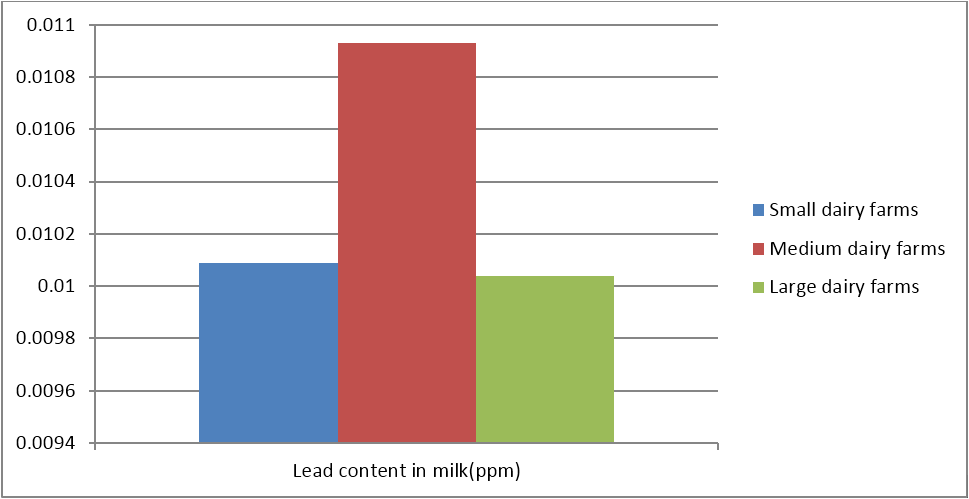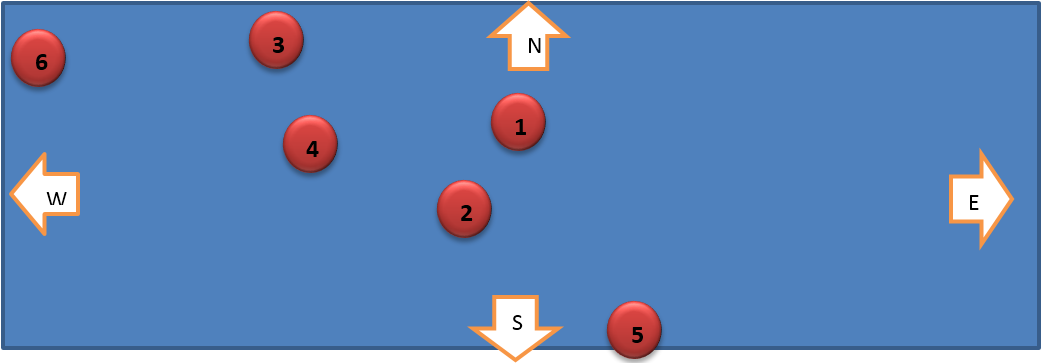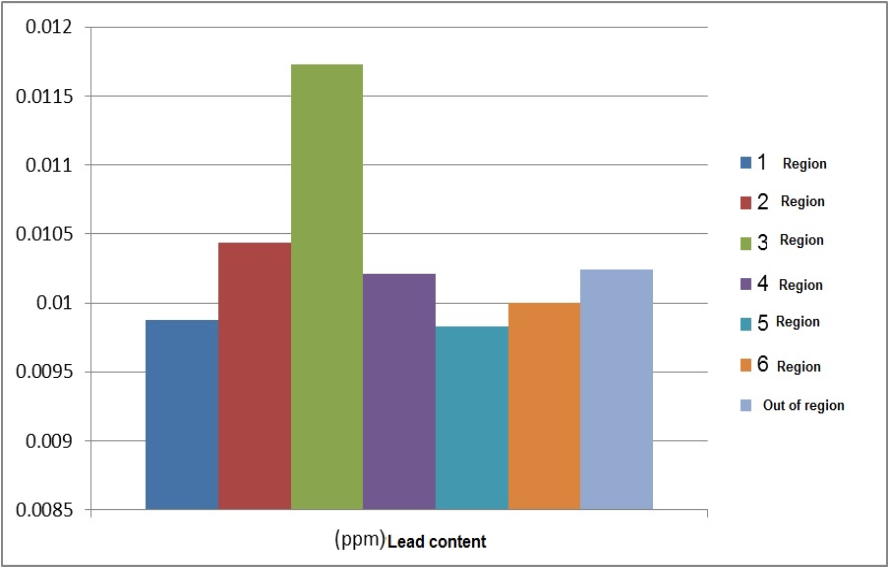Research Article
Volume 3 Issue 1 - 2018
Study the Lead Content of Raw Milk of Kalleh Dairy Company in Tehran
Kalleh Company, Iran
*Corresponding Author: Salman Seyednasrollah Baghban, Kalleh Company, Iran.
Received: May 23, 2018; Published: June 06, 2018
Abstract
The increasing development of technology, however, increases the quality of life, but this phenomenon has resulted in an increase the amount of pollutants and multiple environmental problems. Some of these pollutants and toxic compounds such as dioxins, poisons, heavy metals and metalloids directly and indirectly enter the human food chain. Among the pollutants that enter the human food chain can be referred to heavy metal, especially lead which is of particular importance. The study was conducted by improving milk supply unit of Kalleh in autumn of 2016. Sampling of milk suppliers was done in Tehran. 7 samples were taken for testing lead from any supplier which was totally 105 samples. Testing methods lead was conducted with spectrometer optical atomic absorption. In this study, it was found that, all samples of milk in terms of their lead were under the standard amounts which were based on Codex standards. Lead levels in studied milk samples were 0.01 ppm. Given that the standard amount of codex was 0.02 ppm that was indicative of proper condition. 38 dairy farms for milk production were divided to 3 small groups (below 5 tons), medium (5 to 10 tons) and large (over 10 tons). There was no significant difference between groups. 58 percent of dairy farms in small groups, 26 percent in medium and 16 percent in large.in order to evaluate the different regions of Tehran, 7 regions were specified and their dairy farms’ milk in terms of the lead checked out. There was no significant difference in the lead-milk dairy farms in different regions.
Keywords: Lead; Raw milk; Dairy farm; Kalleh Company
Introduction
The increasing development of technology, however, increases the quality of life, but this phenomenon has resulted in an increase the amount of pollutants and multiple environmental problems (Celik and Oehlenschlager, 2007). Some of these pollutants and toxic compounds such as dioxins, poisons, heavy metals and metalloids directly or indirectly enter the human food chain (Tajkarimi., et al. 2008). Among the pollutants that enter the human food chain can be referred to heavy metals, especially lead which are of particular importance (Vahidinia., et al. 2013). Among foodstuff, milk is considered more than others, because milk and dairy products in many parts of the world are constituted an important part of the human diet due to its high nutritional value and consumption of these products by all ages especially infant and children (Harding, 1995). Heavy metals are those metals that are specific gravity is greater than 5 grams per cubic centimeter. In this group are about 69 metals in nature and regarding some of them toxicology information is not enough (Rokni, 2007)، (Vos and Van Delft 1988) and (Wtson., 2001). Heavy metals are the most important chemical pollutants of foodstuff and their presence in foodstuff of animal origin will increase the continuous possibility of human exposure to them (maybe for all life). Today, in countries and developed societies heavy metal contaminants are formed one of the health and environmental issues (Rokni, 2007) (Vos and Van Delft, 1988) and (Watson, 2001).The main problem with heavy metals that are not metabolized in the body. In fact, they are not excreted from the body after entering the body and accumulate in the tissues (Giti Karim., et al. 2012). Kalleh Iran Dairy Company was made known as 48th brands in the world in food industry by the International Institute (euro monitoring) (Wikipedia). The company's products in addition to provide the interior need, has a clear vision in exporting to abroad and could obtain share in Asia, Europe and America. Kalleh is an Iranian Company in production of dairy products which is headquartered in Amol, Mazandaran. The company was founded in 1990 by Mr. Gholamali Soleimani in Amol. It has been producing dairy products such as any kinds of milk besides other products including butter, cheese, yogurt, doogh. Kalleh was chosen as top exporter of the country in 2009, 2010, 2013 and 2014 and its drinks received health and safety medal. Production of high quality dairy products is at the forefront of this company, for this reason it won a ward of national pride in export on the 20 October 2016. The incoming raw materials in this company are received after various experiments and confirm the authenticity of intended goods and consequently, the product is of acceptable quality.
Review Sources
According to the procedure of environmental pollutions in the world, the basis of many researches about transferring a lot of heavy metals to milk has been provided. Lead can enter to livestock's body through their feed, water and inhale. Studies of milk in clean areas and areas adjacent traffic motor vehicles show that lead found in milk from both locations are acceptable and relatively low (Karim., et al. 2012). Livestock feed with hay soaked in lead shows that majority of consumed lead by dairy cows don’t enter into the milk. In fact, the cow's body effectively acts as a biological filter and takes entered lead from feed to bone tissue instead of milk (Harding, 1995). High concentration of lead in the blood and precipitation in these areas is causing pain in muscles and joints in addition, lead causes to disturbance in the synthesis of molecules of iron, resulting in anemia (Bonyadian., et al. 2006).
According to the procedure of environmental pollutions in the world, the basis of many researches about transferring a lot of heavy metals to milk has been provided. Lead can enter to livestock's body through their feed, water and inhale. Studies of milk in clean areas and areas adjacent traffic motor vehicles show that lead found in milk from both locations are acceptable and relatively low (Karim., et al. 2012). Livestock feed with hay soaked in lead shows that majority of consumed lead by dairy cows don’t enter into the milk. In fact, the cow's body effectively acts as a biological filter and takes entered lead from feed to bone tissue instead of milk (Harding, 1995). High concentration of lead in the blood and precipitation in these areas is causing pain in muscles and joints in addition, lead causes to disturbance in the synthesis of molecules of iron, resulting in anemia (Bonyadian., et al. 2006).
In study of Shahr e kord city lead content in raw and pasteurized milk was measured using potentiometric method. In this study which was conducted on 100 sampled of raw milk and 50 samples of pasteurized milk, all of the samples based on lead contamination were under the standard levels (Bonyadian., et al. 2006). In study of (Hayatbakhsh, 2006) which was done of lead contamination in 10 samples of pasteurized and 10 samples of sterilized milk, the lead levels in all samples were estimated lower than standard levels. In study of (Abdulkhaliq., et al. 2012), they examined the levels of cadmium and lead in 160 samples of cow's milk (powdered milk or dried milk) and results showed that lead and cadmium concentrations in milk were exceeded (Abdulkhaliq., et al. 2012). In study of (Salah Fathy., et al. 2013), they examined amount of cadmium and lead in 50 samples of milk in Daklya Egypt with atomic absorption spectrophotometry. According to study findings, the amount of these elements was higher than allowed and warned to the toxic effects of these elements on the health of children and adults (Salah Fathy., et al. 2013).
Even though cows can stand lead to 100 mg per kg of feed without significant effects, the maximum tolerable lead in their feed was set 30 mg per kg. Consumption of lead for 200 mg per kilogram is fatal for cows. Young cows compared with adults, are more susceptible to lead poisoning because lead absorption in young animals is more than adults (90 percent vs. 10 percent). As well as complication of Pica in young cows is more than adults (Nikkhah and Amanlou, 2002). It is necessary to monitor potential sources of food contamination, especially milk and its products regularly. In addition, the monitoring of heavy metals in milk and other dairy products should have been in the agenda of health and regulatory organizations. It is also necessary to have a suitable method yet low cost test for continuous measuring the foodstuff. Currently using methods such as atomic absorption, furnaces and plasma are very expensive and there aren't facilities and funds of using these methods continuously (Mollayiparvari., et al. 2014).
It should be noted that the basis of comparison, is Codex standards which every few years has been developed by the World Organization of Agriculture, they determine the contaminant limits and additives in food for human consumption. According to the Codex 2000 allowable lead level of milk was listed 1000 ppb, this amount has been reduced to 20 ppb in Codex 2007, which should be considered because of the importance of reducing 98 percent of the remaining risks of lead on human health by International Agricultural Organization (Bonyadian., et al. 2006). In many countries, including Iran, extensive studies regarding lead poisoning have been done and determined the amount of lead in milk or lead in foodstuff, these studies in a case of milk are important from two aspects. One aspect is of public health to lead contamination of milk and transmit it to humans and another aspect of potential toxicity in livestock (Radmehr., et al. 2009). (Swarup., et al. 2005) in India examined the blood lead levels in dairy cows of dairy farms which were in surrounding industrial plants to determine the relation between lead levels in milk and dairy cows' blood. In this experiment the maximum amount of lead in milk was 840 ppb which were identified from livestock around the Aluminum plants and steel works (Swarup., et al. 2005). In study of (Radmehr., et al. 2009) examined water as one of the possible sources of contamination. About lead content in the water of dairy farms, given the low levels of lead in water, water cannot be considered a source of contamination and other possible sources of contamination must be examined.
Materials and Methods
The study was conducted by improving milk supply unit of Kalleh in autumn of 2016. Sampling of milk suppliers was done in Tehran. 7 samples were taken for testing lead from any supplier which was totally 105 samples. Testing methods lead was conducted with spectrometer optical atomic absorption. At first in this method, the dried sample and then by increasing temperature gradually (50°C per hour or more) in the range of 50 ± 500 degrees Celsius and eventually turns gray. At this point in 6 Molar HCl solution added and evaporation is drying up. Remained at 0.1 Molar solution of Nitric Acid solution and then to determine the amount of elements Atomic Absorption Bnyab method, using flame and graphite furnace. Finally the statistical analysis was performed with software spss22. In addition, the condition of dairy farms were measured in terms of lead examined the effect of different geographical areas and the amount of milk tonnage on lead.
Results and Discussion
In this study, the lead content in milk of Tehran's dairy farms was checked out to find it to be free of lead. Public health depends on safe manufacturing and thus expands consumption by exports of dairy products. It was found that, all samples of milk in terms of their lead were under the standard amount of lead which was based on Codex standards. Lead levels in studied milk samples were 0.01 ppm. Given that the standard amount of codex was 0.02 ppm that was indicative of proper condition. 38 dairy farms for milk production were divided to 3 small groups (below 5 tons), medium (5 to 10 tons) and large (over 10 tons). Usually there are large volumes of purchasing inputs in large dairy farms to provide the necessities of the season or in some cases for whole year however, medium-sized dairy farms usually supply just fractional inputs. Considering the number of feed contamination is more likely than large dairy farms. Duncan Test was used to figure the matters out. No significant difference was observed between groups. 58 percent of dairy farms in small groups, 26 percent in medium and 16 percent in large. The below diagram indicates the issue.
As it is clear from the above diagram, the best performance in terms of tonnage is for large dairy farms. The higher average level of lead in dairy farms represents multiple inputs and lack of control .Also there is a good condition in small dairy farms due to less number of inputs. Tehran is as one of the poles of milk production along with Esfahan in Iran. Being wide for Tehran where is the capital of Iran causes of large differences in climate and water. Tehran city with approximately 8,000,000 populations and the area of 730 square kilometers is twenty-fifth populous and twenty-seventh big cities in the world. The background of living in Tehran returns to 5000 BC. The dairy farms of Tehran are located in non-urban and suburb regions. In order to evaluate the different regions of Tehran, seven regions were identified and their dairy farms’ milk tested for lead.
The following figure represents the geographic dispersion
How marking regions was based on the highest frequency, so that there are 29 percent of samples in region 1, 16 percent in the region 2, in regions 3, 4 and out of that (Decentralized distribution in irrigated regions), Each of them was 13 percent, 11 percent of samples related to region 5 and 5 percent of the remaining is related to the region 6. There was no significant difference in various regions of the farms milk Lead.
Below diagram shows the lead content in different geographic regions of Tehran.
Region 3 is related to Karaj city. The most frequent industrial plants located in the west of Tehran or Karaj city that should be studied the effects of air and water pollution. It should be noted that the lead content in this region is acceptable but necessary measures should be taken to control it in the future.
Conclusion
- The lead content of milk in Tehran is standard.
- Large dairy farms have the lowest lead content in milk.
- Karaj, however, is sub-standard, but has highest lead contamination compared to others.
- Following numerous studies and other researchers on lead control in Iran, the lead content is under the Codex MRL standards.
References
- Bonyadiyan., et al. “Study of Pb and Cd in raw and pasteurized milk produced in Shahr e Kord.” Veterinary Journal 2 (2006): 74-80.
- Hayatbakhsh., et al. Study of lead levels in some plants, pasteurized and sterilized milk in Tehran by graphite furnace method, PhD Thesis of veterinarian, Faculty of Veterinary Medicine, Tehran University (2007): 85.
- Radmehr., et al. “The relationship of lead in the drinking water herds of Tehran” Journal of Clinical Veterinary Medicine, the first issue (2009): 49-56.
- Karim., “Contamination of foodstuff with origin of livestock and aquatic of heavy elements in the country.” the Journal of Food Science 34 (2012): 25-35.
- Mollayiparvari., et al. “Determine the level of lead and cadmium in industrial milk used in the food industry in Tehran.” food hygiene 4.16 (2015): 69-74.
- Nikkhah., et al. “Nutrient requirements of dairy cows, America magazine National Research Council (NRC).” University of Zanjan (2002): 234.
- Vahidiniya., et al. “The study of lead content, cadmium and related factors in raw milk produced in various regions of Hamedan province, food hygiene.” 3 (2013): 39-46
- Adulkhaliq., et al. “Levels of metals (Cd, Pb, Cu and Fe) in cow's milk, dairy products and hen's eggs from the West Bank, Palestine.” International Food Research Journal 19.3 (2012): 1089-1094
- Celik., et al. “High contents of cadmium, lead, zinc and copper in popular fishery products sold in Turkish supermarkets.” Food Control 18.3 (2007): 258-61
- Codex alimentarius commission, Report of the 35th Session of the codex committee on food Additives and contaminants Arusha, Tanzania (2007).
- European Commission Commission Regulations (EC) No, 1881/2006 of 19 December 2006, setting maximum levels for certain contaminants in food stuffs (2006).
- Harding., et al. “Milk quality: Springer Technology &Industrial Arts.” U.k (1995).
- https://fa.wikipedia.org/wiki/
- Rokni., et al, “Principles of Food Hygiene, University of Tehran Press.” Tehran 43-50.
- Salah Fathy., et al. “Assessment of toxic heavy metals in some dairy products and the effect of storage on its distribution.” Journal of American Science 8.8 (2012): 665-670.
- Swarup., et al. “Blood lead levels in lactating cows reared around polluted localities; transfer of lead into milk.” Science of the Total Environment 347.1 (2005): 106-110.
- Tajkarimi., et al. “Lead residue levels in raw milk from different regions of iran.” Food Control 19.5 (2008): 495-8.
- Vos G., et al. “Arsenic, Cadmium, Lead and Mercury in meat, liver and kidney of sheep slaughtered in the Netherland, Lebensm unters Forch.” 187.1 (1988): 1-7
- Watson DL. “Food Chemical safety, Contaminants.” Woodhead Publishing 1 (2001): 2.
Citation:
Salman Seyednasrollah Baghban., et al. “Study the Lead Content of Raw Milk of Kalleh Dairy Company in Tehran”. Nutrition
and Food Toxicology 3.1 (2018): 558-563.
Copyright: © 2018 Salman Seyednasrollah Baghban., et al. This is an open-access article distributed under the terms of the Creative Commons Attribution License, which permits unrestricted use, distribution, and reproduction in any medium, provided the original author and source are credited.






































 Scientia Ricerca is licensed and content of this site is available under a Creative Commons Attribution 4.0 International License.
Scientia Ricerca is licensed and content of this site is available under a Creative Commons Attribution 4.0 International License.